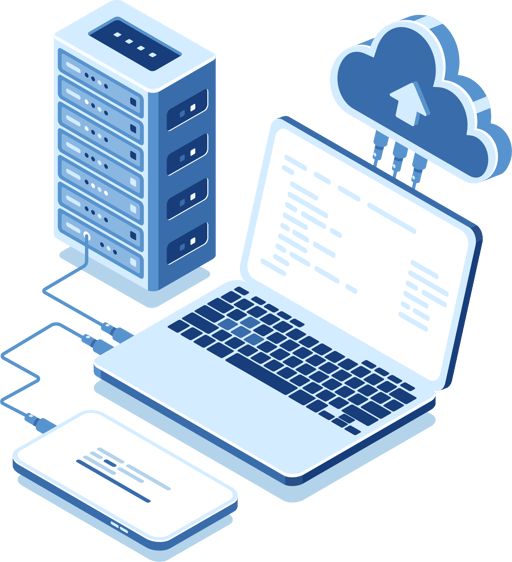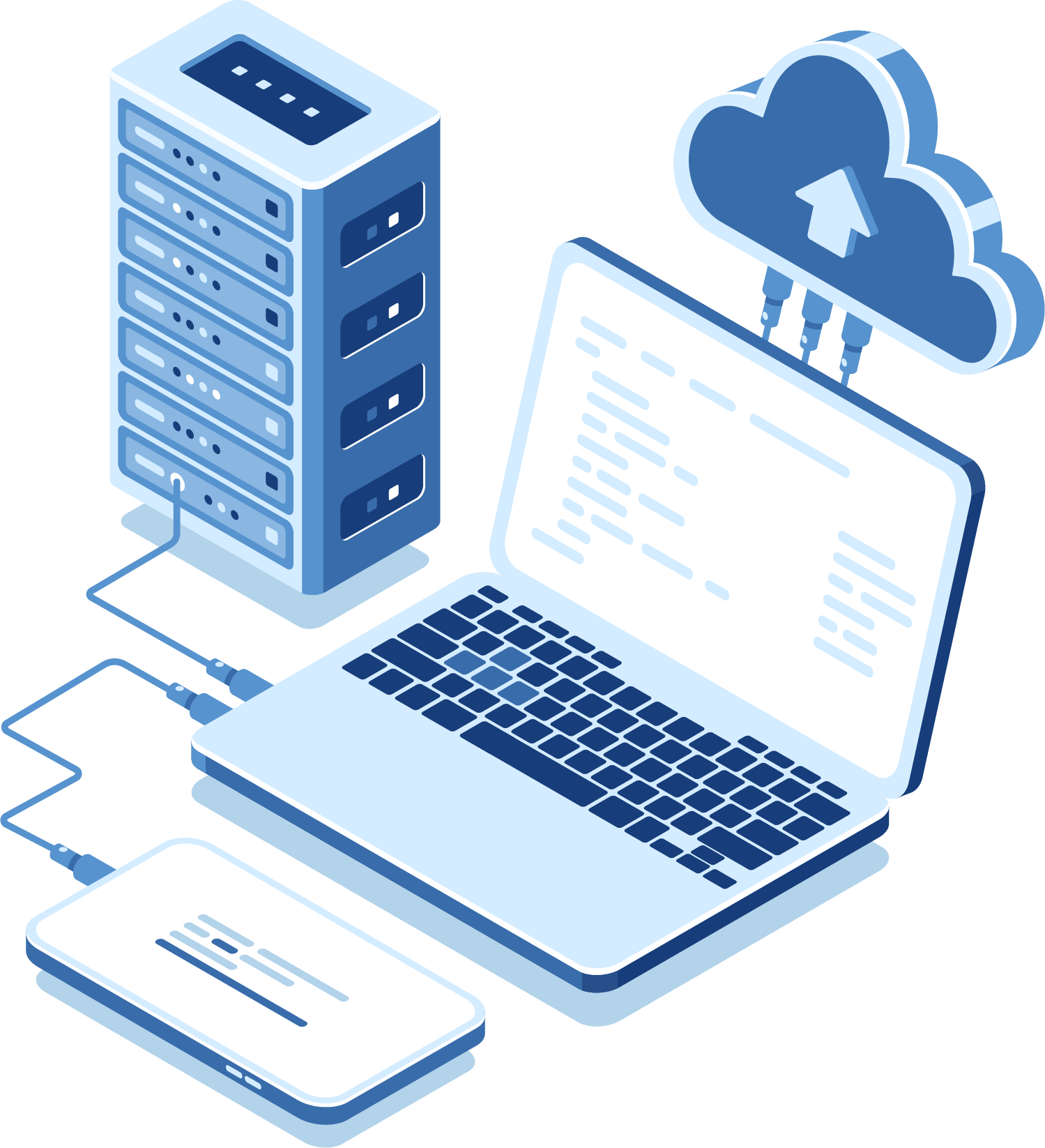Would you like a trustworthy ally at your side?
We'd be delighted to serve you with development skills tailored to your company's high-quality standards.
Hire the best SaaS application developers for your project.


To develop a SaaS you need programmers. A group of programmers who possess a variety of knowledge related to web development. There are two main areas of expertise in web development. The frontend, used for everything that's visible as well as interactions and animations, and the backend, which contains the business logic, database and link between the various application components.
You'll need at least one front-end and one back-end developer. Or what we call a fullstack developer, a developer who masters both aspects of web development. This type of project can be a daunting task, so a team of several programmers is usually required to complete a project. A team of more than 5 to 10 people is conceivable for a large-scale project. You need to have a number of experienced developers on your team, or work with a development firm, or hire developers.
Your programmers will need to use a framework and programming language suited to this kind of application. Turnkey CMS like WordPress, Drupal or e-commerce software like Magento and Prestashop won't be suitable.
Some SaaS software is easier to develop than others, and can even be built within the cloud itself. This is known as the "serverless" approach. Otherwise, they will have to be deployed on a more traditional infrastructure.
The complexity of your software will largely depend on the complexity of the functions to be implemented, the number of users expected and the choice of infrastructure. Companies and entrepreneurs wishing to create larger-scale applications will need a sizeable team and at least several months' work.
While all web programmers may be able to participate in the design and realization of a SaaS, this task is usually reserved for more experienced programmers. Designing SaaS involves many difficulties. They are often database-intensive, and require particular attention to data structure. Software as a Service is becoming more and more business-critical, so it has to be online all the time and respond appropriately to user requests without delay. What's more, additional tasks need to be performed to ensure constant data backup and security. Infrastructures of this kind are often complex, and depending on the type of infrastructure used, may be inaccessible to less experienced programmers.
SaaS consists of a backend and a frontend. The frontend and backend technologies chosen by SaaS designers are varied, but some technologies are used more often than others. Back ends using Python with Django, Ruby with Ruby on Rail and JavaScript with NodeJs are common choices for designing the backend of this type of project. So it's often programmers who have mastered these technologies who are real SaaS developers. As for the front end, JavaScript is the order of the day, with tools such as Angular and ReactJS.
It's important to understand, however, that the key to the success of a SaaS project often lies in the experience of the team members, rather than the technology used.

There are a number of tools and languages you can use to build your SaaS. Among the wide range of languages that can be used by programmers, PHP, JavaScript, C#, Python and Ruby are the languages most often used for this type of development.
As for frameworks. We generally find the following frameworks.
Django for Python
Ruby on Rail for Ruby
.net for C#
CodeIgniter, Laravel or Symphony for PHP
Many CTOs and programmers today are opting for cloud solutions. This solution saves time and, in many cases, can offer substantial cost savings. It often requires knowledge specific to the cloud provider employed. The great strength of these solutions is the elasticity of the resources used. In fact, it's possible to easily increase or reduce the resources used and pay per use. This makes it possible to adapt quickly to an increase or decrease in the resources required to meet user needs.
Dedicated servers are physical servers that are purchased or leased. They are still viable even in the cloud era. They may even be less expensive in terms of hosting bills, but they generally need longer set-up times and may require more maintenance. Both types of solution have their advantages and disadvantages. The choice will depend very much on your available resources. This approach lacks the elasticity provided by cloud solutions and is often more time-consuming to set up. However, it is possible to have a lower total bill with dedicated servers than with cloud solutions. It's often the server management time and other headwords associated with dedicated servers that raise the real bill. Many network administrators still advocate this approach.
This approach is relatively new, and requires specific knowledge of the tools provided by one of the major cloud hosting providers, such as Amazon AWS or Microsoft Azure. Your application is developed directly in a cloud environment, using the tools provided by the provider. To take the example of Amazon AWS tools, it is possible to build a complete application using Amazon's various cloud products. Using products such as Amazon Cognition, S3, API Gateway, DynamoDB, AWS lambda, SES, and SAM/Cloud Formation.
Each of the tools provided has a specific purpose.
A small SaaS application that strictly uses a serverless architecture can be developed quickly if the person building it is familiar with the tools he or she is using. Otherwise, the learning curve can be tedious, as it involves many different services, proprietary to the cloud provider, that have to fit together.
The serverless approach has a number of advantages. Firstly, it theoretically allows infinite demand growth for the application using this approach (scalability). As the infrastructure is 100% in the cloud, with theoretically unlimited resources, it can increase its resource utilization linearly, without having to think too hard about it.
VPSs are often confused with cloud solutions, as they often use the same key words - "cloud" and "nuagic" - in their marketing approach. Often less expensive than a true cloud solution, VPSs are actually virtual environments running on a standard server. In some cases, the line is very thin, and many features usually reserved for cloud environments can be found in VPSs.
This is the case with DigitalOcean, a very popular VPS provider with an increasing number of cloud-like functions. Dedicated backup copy, load balancer, DNS management and more.
VPSs are the equivalent of a dedicated server in use, but it's actually a reserved area within a larger server. Often, your RAM is dedicated, but the CPU cores are shared with the users of the server where the VPS resides. VPSs on the same machine share resources, but the machine has sufficient resources to host multiple virtual machines.
Software as a Service can take different approaches to managing the separation of the multiple organizations or users the software will serve. These different approaches all have their advantages and disadvantages, and your developer will be able to tell you more about them and suggest the right approach for your project.
The multiple database (or multi-instance) approach
The single-database approach
The schematic approach
We'd be delighted to serve you with development skills tailored to your company's high-quality standards.
Get in touch with our expert tech consultants to vet your idea/project in depth.
Let's brainstorm on potential solutions with a precise estimate and then you decide if we're a match.